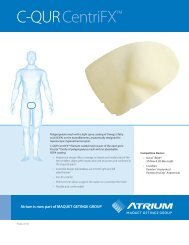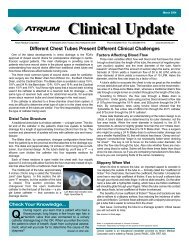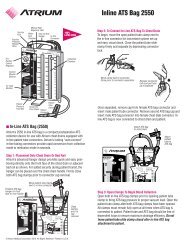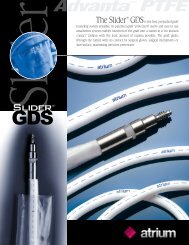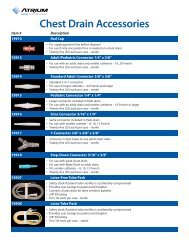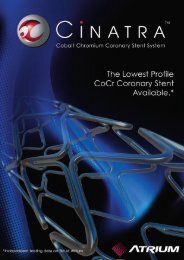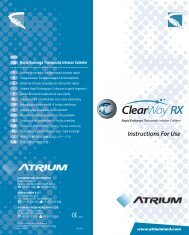iCAST™ Instructions for Use (IFU) - Atrium Medical Corporation
iCAST™ Instructions for Use (IFU) - Atrium Medical Corporation
iCAST™ Instructions for Use (IFU) - Atrium Medical Corporation
Create successful ePaper yourself
Turn your PDF publications into a flip-book with our unique Google optimized e-Paper software.
C<br />
S<br />
C O V<br />
E R<br />
E D<br />
S T<br />
E N<br />
T<br />
•035<br />
GUIDEWIRE<br />
T E C H N O<br />
T<br />
L O G<br />
Y<br />
<strong>Instructions</strong> For <strong>Use</strong>
<strong>Instructions</strong> For <strong>Use</strong><br />
DESCRIPTION<br />
The iCAST Covered Stent is a balloon expandable endoluminal<br />
device consisting of a laser cut 316L stainless<br />
steel stent with an encapsulated cover made of expanded<br />
PTFE. The device is crimped and premounted to a<br />
multi lumen delivery catheter. The catheter main or wire<br />
(W) lumen is used <strong>for</strong> flushing and guidewire introduction.<br />
The secondary or inflation (I) lumens are used <strong>for</strong><br />
inflation/deflation of the attached balloon to deploy the<br />
endoprosthesis. To facilitate accurate device placement,<br />
two radiopaque bands are attached to the catheter shaft<br />
marking the ends of the crimped device.<br />
The iCAST Covered Stent is supplied STERILE.<br />
INTENDED USE/INDICATIONS<br />
The iCAST Covered Stent is indicated <strong>for</strong> the treatment<br />
of tracheobronchial strictures produced by malignant<br />
neoplasms.<br />
CONTRAINDICATIONS<br />
Non-Compliant Obstructions where full expansion of a<br />
balloon dilatation catheter can not be achieved during<br />
pre-dilation, or where obstructions can not be dilated<br />
sufficiently to allow passage of the delivery catheter.<br />
WARNINGS<br />
• The safety and effectiveness of this device <strong>for</strong> use in<br />
the vascular system have not been established and<br />
can result in serious harm and/or death.<br />
• The use of metallic tracheal stents may preclude the<br />
success of subsequent surgical procedures and<br />
should be considered only <strong>for</strong> patients after all alternative<br />
therapies have been exhausted. Please consider<br />
the use of tracheal surgical procedures or placement<br />
of silicone stents be<strong>for</strong>e using metallic tracheal<br />
stents.<br />
• Do not use the iCAST Covered Stent in a non-compliant<br />
lesion where full expansion of the balloon dilatation<br />
catheter, appropriately sized <strong>for</strong> the lumen, can<br />
not be obtained.<br />
• Special care should be taken to ensure that the<br />
appropriate size device, guidewire (if used), compatible<br />
bronchoscope (if used) and endotracheal tube (if<br />
used) are selected prior to introduction. Native lumen<br />
dimensions must be accurately measured, not estimated.<br />
• Do not cut the device. The device should only be<br />
placed and deployed using the supplied balloon<br />
catheter.<br />
• Do not use a kinked bronchoscope or endotracheal<br />
tube as this may increase the <strong>for</strong>ce necessary to<br />
deploy the device and may cause a deployment failure<br />
or catheter breakage on removal.<br />
• Do not withdraw the iCAST Covered Stent back into<br />
the bronchoscope or endotracheal tube once the<br />
device is fully introduced.<br />
• Inadvertent, partial, or failed deployment or migration<br />
of the device may require surgical intervention.<br />
• Do not remove the iCAST Covered Stent from the balloon<br />
delivery catheter; the iCAST Covered Stent cannot<br />
be removed and placed on another balloon<br />
catheter <strong>for</strong> deployment.<br />
• Special care must be taken not to handle or in any<br />
way disrupt the placement of the iCAST Covered Stent<br />
on the balloon. This is most important during<br />
catheter removal from packaging, placement over the<br />
wire guide and advancement through the bronchoscope<br />
or endotracheal tube.<br />
• <strong>Use</strong> only the appropriate balloon inflation media. Do<br />
not use air or any gaseous medium to inflate the balloon.<br />
• Balloon pressures should be monitored during inflation.<br />
Do not exceed maximum recommended inflation<br />
pressures as indicated on the product label.<br />
Exceeding this pressure increases the potential <strong>for</strong><br />
balloon rupture and possible damage.<br />
• Expansion of the iCAST Covered Stent should not be<br />
undertaken if the iCAST Covered Stent is not appropriately<br />
positioned in the tracheal. If the position of<br />
the stent is not optimal, it should not be expanded.<br />
• Prior to stent expansion, utilize high-resolution fluoroscopy<br />
to verify that stent has not been damaged or<br />
dislodged during positioning.<br />
• Incomplete deployment of the stent (i.e., stent not<br />
fully expanded) may cause procedural complications<br />
resulting in patient injury.<br />
• <strong>Use</strong> caution when using the iCAST Covered Stent in<br />
patients with prolonged bleeding times, coagulopathies,<br />
prior pneumonectomy, or concurrent infection<br />
and/or inflammation (as this may lead to granuloma<br />
<strong>for</strong>mation), or in cases where the obstruction is in<br />
very close proximity to a major blood vessel (as this<br />
may lead to fistula <strong>for</strong>mation).<br />
PRECAUTIONS<br />
• Federal law restricts this device to sale by or on the<br />
order of a physician.<br />
• <strong>Use</strong> of the system requires advanced technical skills.<br />
The following instructions will give technical guidance<br />
but do not obviate <strong>for</strong>mal training in the use of the<br />
device.<br />
• Significant amounts of air in the balloon may cause<br />
uneven expansion of the stent and difficulty in deployment<br />
of the stent. Do not pre-inflate the balloon<br />
prior to stent deployment. <strong>Use</strong> balloon-prepping technique<br />
described within this instructional material.<br />
• Do not attempt to pull an unexpanded stent back<br />
through the bronchoscope or endotracheal tube since
dislodgement of the stent may result (refer to<br />
REMOVAL OF AN UNEXPANDED STENT).<br />
• Prior to completion of the procedure, utilize fluoroscopy<br />
to ensure proper positioning of the deployed<br />
stent. If the target stricture is not covered fully, use<br />
additional stents as necessary to adequately treat the<br />
stricture.<br />
• A magnetic resonance imaging (MRI) scan should not<br />
be per<strong>for</strong>med until the implant has been completely<br />
epithelialized, in order to minimize the risk of migration<br />
of the stent under a strong magnetic field. The<br />
316L stainless steel stent may cause susceptibility<br />
artifacts in MRI scans due to distortion of the magnetic<br />
field.<br />
• The device is provided sterile, <strong>for</strong> one procedure only.<br />
Do not re-sterilize. <strong>Use</strong> prior to the expiration date<br />
noted on the package.<br />
• Do not use the iCAST Covered Stent if the sterile<br />
package is compromised or the iCAST Covered Stent<br />
is damaged.<br />
• Follow the Directions <strong>for</strong> <strong>Use</strong> supplied by the manufacturer<br />
of any ancillary device used in conjunction<br />
with the iCAST Covered Stent.<br />
• Once deployment is initiated, repositioning and<br />
removal is not recommended.<br />
• Do not attempt to withdraw or reposition a balloon<br />
catheter within the lumen of the deployed device<br />
unless the balloon is completely deflated.<br />
HAZARDS AND ADVERSE EVENTS<br />
As with all procedures that utilize techniques <strong>for</strong> introducing<br />
a catheter, bronchoscope, endotracheal tube, or<br />
introducer sheath into the tracheobronchial system<br />
lumen, complications may be expected. Similarly, complications<br />
and adverse events can occur when using any<br />
endoluminal device in the tracheobronchial application.<br />
These include, but are not limited to: endoprosthesis<br />
misplacement, endoprosthesis migration, aphonia,<br />
recurrent dyspnea, infection, septic shock, endoprosthesis<br />
occlusion due to tumor or granulomatous tissue<br />
overgrowth at the device ends, mucous accumulation<br />
within the endoprosthesis, tracheobronchial wall ulceration,<br />
per<strong>for</strong>ation or hemorrhage, and death.<br />
<strong>Atrium</strong> <strong>Medical</strong> iCAST Covered Stent has not been tested<br />
<strong>for</strong> safety in the MRI environment; there<strong>for</strong>e, MRI scans<br />
should not be per<strong>for</strong>med on patients post-implantation<br />
until the stent has completely epithelialized to minimize<br />
the potential <strong>for</strong> migration.<br />
DIRECTIONS FOR USE<br />
Sizing and Selection of the iCAST Covered Stent<br />
To achieve accurate measurement and ensure precise<br />
sizing and placement of the device, use image-centered,<br />
magnified-view fluoroscopy, including a marker<br />
guidewire or catheter.<br />
Check that the diameter and length of the device as well<br />
as the balloon catheter length are correct be<strong>for</strong>e removing<br />
from the packaging.<br />
• In selecting the appropriate size device, a<br />
careful assessment of the lumen is necessary.<br />
In general, to assure adequate anchoring,<br />
the diameter of the device should be<br />
approximately 5-20% larger than the healthy<br />
lumen diameter immediately proximal and<br />
distal to the target lesion (See STENT SIZING<br />
TABLE on label).<br />
• Verify that there is sufficient catheter length<br />
to access the target lesion.<br />
• When overlapping (telescoping) multiple<br />
devices, the following are suggested:<br />
• Balloon touch-up (post-dilatation) should be<br />
per<strong>for</strong>med on the first device prior to placing<br />
the second device.<br />
• To ensure proper seating, at least 1 cm of<br />
overlap between devices is suggested.<br />
• Overlapping devices should not differ by<br />
more than 1 mm in diameter.<br />
Preparation of the iCAST Covered Stent and<br />
Delivery Catheter<br />
1. Remove the iCAST Covered Stent balloon catheter<br />
from the package.<br />
2. Inspect the iCAST Covered Stent to assure it has not<br />
been damaged.<br />
3. Prepare the balloon lumen with the standard contrastsaline<br />
mixture as follows:<br />
a. <strong>Use</strong> a 20 cc syringe containing 5 cc of<br />
contrast-saline mixture and apply negative<br />
pressure <strong>for</strong> 20 to 30 seconds.<br />
b. Release pressure allowing negative pressure<br />
to draw the mixture into the balloon<br />
lumen.<br />
c. Detach the syringe, leaving a meniscus of<br />
mixture on the hub of the balloon lumen.<br />
d. Prepare the inflation device in the standard<br />
manner and purge to remove all the air<br />
from the syringe and the tubing.<br />
e. Attach the inflation device to the balloon<br />
lumen directly, ensuring no air bubbles<br />
remain at the connection. Do not pull negative<br />
pressure on the inflation device.
f. Carefully check the integrity of iCAST<br />
Covered Stent adhesion to the delivery balloon<br />
by pulling the iCAST Covered Stent<br />
through the thumb and finger. Any movement<br />
of the iCAST Covered Stent should<br />
result in the return of the unused device to<br />
<strong>Atrium</strong> <strong>Medical</strong> <strong>Corporation</strong>.<br />
4. Moisten the iCAST Covered Stent with saline.<br />
5. Carefully advance the iCAST Covered Stent balloon<br />
catheter over the wire guide if using a guidewire.<br />
CAUTION: If resistance is encountered, do not <strong>for</strong>ce<br />
passage, Refer to REMOVAL OF AN UNEXPANDED<br />
iCAST Covered Stent.<br />
6. The iCAST Covered Stent balloon catheter can now be<br />
advanced.<br />
Introduction and Positioning of the iCAST<br />
Covered Stent<br />
1. If a bronchoscope or endotracheal tube is used,<br />
ensure the size is compatible (See STENT SIZING<br />
TABLE on label) with the selected iCAST Covered<br />
Stent.<br />
2. Ensure the guidewire (if used) is ≤0.035” and has a<br />
length at least twice that of the balloon catheter.<br />
3. Care should be taken to maintain the position of the<br />
guidewire (if used) beyond the obstructing lesion<br />
while removing the balloon catheter. If the guidewire<br />
is displaced, proper guidewire position should be<br />
regained prior to introduction of the iCAST Covered<br />
Stent.<br />
Note: If a bronchoscope or endotracheal tube is used<br />
and excessive resistance is felt as the iCAST Covered<br />
Stent is introduced through the bronchoscope or<br />
endotracheal tube carefully remove and inspect the<br />
delivery system <strong>for</strong> damage. Do not reuse the iCAST<br />
Covered Stent if damaged. Confirm that a correctly<br />
sized bronchoscope (if used) or endotracheal tube (if<br />
used), have been selected (See STENT SIZING TABLE<br />
on label), and are free of kinks and obstructions.<br />
4. Using fluoroscopic guidance, advance the remainder<br />
of the delivery catheter over the guidewire (if used).<br />
Advance cautiously, especially if resistance is felt.<br />
5. Position the iCAST Covered Stent across the target<br />
lesion using the radiopaque markers on the catheter.<br />
These markers identify the proximal and distal ends of<br />
the device, respectively.<br />
Note: If balloon dilatation of the obstruction is per<strong>for</strong>med,<br />
the iCAST Covered Stent length should cover<br />
the entire lumen segment treated with balloon dilatation.<br />
For treatment of stenotic or obstructive lesions,<br />
the iCAST Covered Stent should extend a minimum of<br />
1 cm proximal and distal to the margins of the lesion.<br />
6. Once the optimal position is verified fluoroscopically,<br />
the device is ready to be deployed.<br />
Deployment of the iCAST Covered Stent<br />
1. Determine the reference diameter prior to iCAST<br />
Covered Stent deployment.<br />
2. Position the iCAST Covered Stent across the lesion,<br />
using the proximal and distal radiopaque markers on<br />
the balloon as a reference point. Optimal placement<br />
requires the proximal end of the iCAST Covered Stent<br />
to be deployed approximately 1 cm proximal to the<br />
beginning of the segment to be stented.<br />
CAUTION: Expansion of the iCAST Covered Stent<br />
should not be undertaken if the iCAST Covered Stent<br />
is not properly positioned in the lesion. If the position<br />
of the iCAST Covered Stent is not optimal, it should<br />
be repositioned.<br />
3. Inflate the balloon to the appropriate pressure to<br />
expand the iCAST Covered Stent. Refer to product<br />
labeling <strong>for</strong> the proper inflation pressure.<br />
4. A 15-30 second inflation time is recommended <strong>for</strong> full<br />
expansion. Refer to product labeling <strong>for</strong> the proper<br />
inflation pressure.<br />
CAUTION: Under expansion of the iCAST Covered<br />
Stent may result in stent movement. Care must be<br />
taken to properly size the iCAST Covered Stent to<br />
endure that the iCAST Covered Stent is in full contact<br />
with the wall upon deflation of the delivery balloon.<br />
CAUTION: Over sizing of the iCAST Covered Stent<br />
and use of higher than recommended inflation pressures<br />
may cause dissection.<br />
5. Using an inflation device, deflate the balloon.<br />
Allow adequate time <strong>for</strong> full balloon deflation.<br />
6. Very slowly withdraw the balloon from the iCAST<br />
Covered Stent, maintaining negative pressure.<br />
7. While maintaining the position of the guidewire (if<br />
used) across the treated lesion, carefully withdraw the<br />
balloon catheter through the lumen of the device and<br />
remove it under fluoroscopic visualization. Moderate<br />
resistance may be felt when the distal tip exits<br />
through the bronchoscope or endotracheal tube.
REMOVAL OF AN UNEXPANDED STENT<br />
Should it become necessary to remove the iCAST<br />
Covered Stent from the lumen prior to deployment and a<br />
bronchoscope or endotracheal tube is being used, do<br />
not withdraw the iCAST Covered Stent back into the<br />
bronchoscope or endotracheal tube after the device is<br />
fully introduced. To remove the iCAST Covered Stent<br />
prior to deployment, the iCAST Covered Stent /balloon<br />
catheter should be withdrawn until the proximal end of<br />
the iCAST Covered Stent is aligned with the distal tip of<br />
the bronchoscope or endotracheal tube. The iCAST<br />
Covered Stent/balloon catheter, guidewire and bronchoscope<br />
or endotracheal tube, should then all be removed<br />
as one unit. After removal, the iCAST Covered Stent<br />
should not be reused.<br />
EMERGENCY WITHDRAWAL PROCEDURE OF AN<br />
EXPANDED STENT<br />
In order to withdraw an expanded stent either in an<br />
emergency or due to misplacement, the following withdrawal<br />
procedure should be followed:<br />
Place a rigid bronchoscope. Pass biopsy <strong>for</strong>ceps through<br />
the rigid bronchoscope. Using <strong>for</strong>ceps capture and compress<br />
the proximal edges of the stent, until it is flattened<br />
and can fit into the opening of the bronchoscope.<br />
Grasp the flattened edge of the stent and pull back into<br />
the bronchoscope to remove the stent. If needed, a<br />
twisting or rotating motion will aid in withdrawal.<br />
Following removal, examine area of stent placement <strong>for</strong><br />
any damaged tissue.<br />
CAUTION: Do not attempt to pull an unexpanded iCAST<br />
Covered Stent back through the bronchoscope or endotracheal<br />
tube; dislodgement of the iCAST Covered Stent<br />
may occur.<br />
SYMBOLS USED ON PRODUCT LABELS<br />
REF<br />
CODE NUMBER<br />
LOT<br />
LOT NUMBER<br />
STERILE EO<br />
STERILE. STERILIZED BY ETHYLENE OXIDE.<br />
SEE PACKAGE INSERT<br />
SINGLE USE ONLY<br />
EXPIRATION DATE<br />
DIM<br />
DIMENSIONS<br />
PRESCRIPTION ONLY<br />
BALLOON EXPANDABLE<br />
COVERED STENT<br />
This device is covered under one or more of the following U.S. patents: 5,925,074; 6,010,529; 5,980,799; 6,270,523 B1.<br />
<strong>Atrium</strong> and iCAST are trademarks of <strong>Atrium</strong> <strong>Medical</strong> <strong>Corporation</strong>. ©2006 All Rights Reserved.<br />
ATRIUM MEDICAL CORPORATION<br />
5 Wentworth Drive, Hudson, New Hampshire 03051 U.S.A.<br />
603-880-1433 603-880-6718<br />
ATRIUM EUROPE B.V.<br />
Rendementsweg 24 L, 3641 SL Mijdrecht, The Netherlands<br />
+31 297 230 420 +31 297 282 653
Product Diameter Length Catheter Length Introducer Part No.<br />
iCast 5 mm 16 mm 80 cm 6 Fr 85440<br />
iCast 5 mm 22 mm 80 cm 6 Fr 85441<br />
iCast 5 mm 38 mm 80 cm 7 Fr 85400<br />
iCast 5 mm 59 mm 80 cm 7 Fr 85401<br />
iCast 6 mm 16 mm 80 cm 6 Fr 85442<br />
iCast 6 mm 22 mm 80 cm 6 Fr 85443<br />
iCast 6 mm 38 mm 80 cm 7 Fr 85402<br />
iCast 6 mm 59 mm 80 cm 7 Fr 85403<br />
iCast 7 mm 16 mm 80 cm 7 Fr 85444<br />
iCast 7 mm 22 mm 80 cm 7 Fr 85445<br />
iCast 7 mm 38 mm 80 cm 7 Fr 85404<br />
iCast 7 mm 59 mm 80 cm 7 Fr 85405<br />
iCast 8 mm 38 mm 80 cm 7 Fr 85406<br />
iCast 8 mm 59 mm 80 cm 7 Fr 85407<br />
iCast 9 mm 38 mm 80 cm 7 Fr 85408<br />
iCast 9 mm 59 mm 80 cm 7 Fr 85409<br />
iCast 10 mm 38 mm 80 cm 7 Fr 85420<br />
iCast 5 mm 16 mm 120 cm 6 Fr 85450<br />
iCast 5 mm 22 mm 120 cm 6 Fr 85451<br />
iCast 5 mm 38 mm 120 cm 7 Fr 85410<br />
iCast 5 mm 59 mm 120 cm 7 Fr 85411<br />
iCast 6 mm 16 mm 120 cm 6 Fr 85452<br />
iCast 6 mm 22 mm 120 cm 6 Fr 85453<br />
iCast 6 mm 38 mm 120 cm 7 Fr 85412<br />
iCast 6 mm 59 mm 120 cm 7 Fr 85413<br />
iCast 7 mm 16 mm 120 cm 7 Fr 85454<br />
iCast 7 mm 22 mm 120 cm 7 Fr 85455<br />
iCast 7 mm 38 mm 120 cm 7 Fr 85414<br />
iCast 7 mm 59 mm 120 cm 7 Fr 85415<br />
iCast 8 mm 38 mm 120 cm 7 Fr 85416<br />
iCast 8 mm 59 mm 120 cm 7 Fr 85417<br />
iCast 9 mm 38 mm 120 cm 7 Fr 85418<br />
iCast 9 mm 59 mm 120 cm 7 Fr 85419<br />
iCast 10 mm 38 mm 120 cm 7 Fr 85424<br />
©2006 <strong>Atrium</strong> and iCast are trademarks of <strong>Atrium</strong> <strong>Medical</strong> <strong>Corporation</strong><br />
003509<br />
www.atriummed.com



